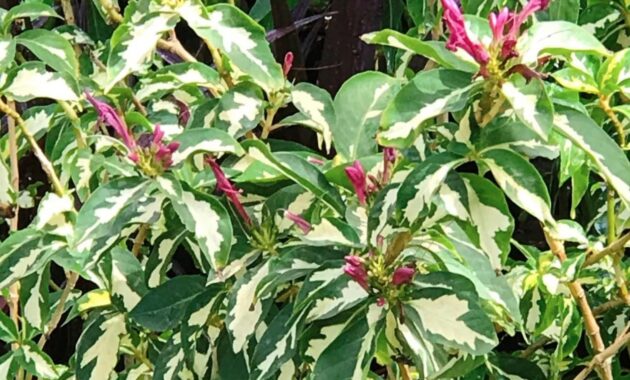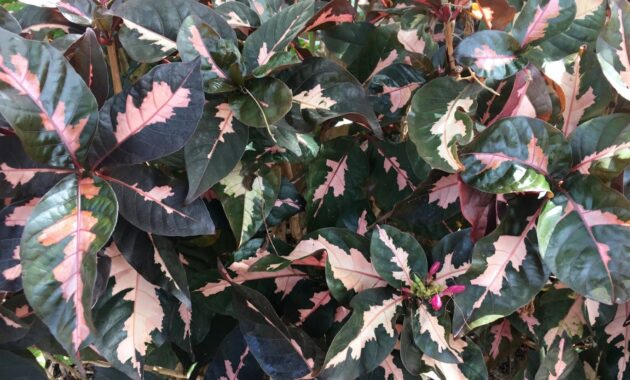
Ah, the Graptophyllum plant! This gem of a plant might not be on everyone’s radar, but let me tell you, it deserves a spot in your garden or indoor plant collection. I first came across Graptophyllum when visiting a friend’s lush garden, and I was immediately captivated by its striking foliage and vibrant colors. It’s not just a pretty face; it has so much to offer. In this guide, we’ll delve into everything you need to know about this unique plant—from its characteristics to care tips and everything in between.
What is Graptophyllum?
Graptophyllum is a genus of flowering plants in the family Acanthaceae. It’s often grown for its ornamental value due to its stunning leaves and interesting growth habit. With a few species to choose from, this plant can easily become the star of your indoor or outdoor space.
Basic Characteristics of Graptophyllum
- Scientific Name: Graptophyllum spp.
- Common Names: Sometimes referred to as graptophyllum or Indian mulberry, though it’s essential to check specific species names, as common names can vary.
- Native Region: Predominantly found in Southeast Asia and tropical regions, thriving in warm, humid environments.
- Growth Habit: Depending on the species, it can be a shrub or a small tree, usually reaching heights of about 3 to 6 feet.
- Leaves: The leaves are usually large, glossy, and come in a range of colors from deep green to variegated patterns, which can include shades of yellow and cream.
Ideal Growing Conditions for Graptophyllum
Growing Graptophyllum can be a rewarding experience, but it’s essential to create the right conditions for this plant to flourish. Here are some key points to keep in mind:
- Light Requirements: Graptophyllum loves bright, indirect sunlight. I learned this the hard way when I placed my first plant in full sun, and the leaves got scorched. If you’re indoors, a spot near a window that filters the light is perfect.
- Soil Type: This plant prefers a well-draining potting mix. I like to use a combination of potting soil, peat, and perlite for the best drainage. It’s crucial to avoid heavy soils, which can lead to root rot.
- Temperature and Humidity: Being a tropical plant, it thrives in warmer temperatures, ideally between 65°F and 85°F (18°C to 29°C). Additionally, high humidity is beneficial. If you live in a drier climate, consider using a humidifier or placing a tray of water with pebbles beneath the pot. I’ve found that grouping plants together can also help create a more humid microclimate.
Watering Your Graptophyllum
Watering is perhaps the most critical aspect of caring for your Graptophyllum. Here’s what I’ve discovered:
- Frequency: Water your plant when the top 1-2 inches of soil feel dry. This usually translates to watering about once a week, but always check the moisture level first. Overwatering can quickly become a problem; I once lost a beautiful specimen due to my eagerness to keep it hydrated.
- Signs of Overwatering: Yellowing leaves and a mushy stem are telltale signs. If you notice these symptoms, let the soil dry out before watering again.
Fertilizing Your Graptophyllum
To promote healthy growth and vibrant leaves, fertilization is key:
- Type: Use a balanced, water-soluble fertilizer. I typically go for a 20-20-20 mix, applying it at half strength during the growing season (spring and summer).
- Frequency: Fertilize every 4-6 weeks during the growing season. I once forgot to fertilize for a few months, and it showed! My plant became leggy and lost some of its vibrant color.

Pruning and Maintenance
Maintaining your Graptophyllum is relatively straightforward, but a bit of pruning goes a long way:
- Pruning: Remove any dead or yellowing leaves regularly to encourage new growth. I like to prune after the growing season ends to shape the plant and remove any unwanted branches.
- Repotting: If you’re growing in a pot and notice the roots are becoming cramped, it’s time to repot! I usually do this every 1-2 years, moving up to a slightly larger pot. It’s amazing how a little extra space can reinvigorate a plant!
Common Pests and Diseases
Like any plant, Graptophyllum can fall victim to pests and diseases. Here’s what to look out for:
| Pest/Disease | Symptoms | Prevention/Treatment |
|---|---|---|
| Spider mites | Fine webbing, stippling on leaves | Spray with water to remove or use insecticidal soap. |
| Aphids | Leaf curling, sticky residue | Spray with a strong stream of water or use neem oil. |
| Fungal infections | Wilting, yellowing leaves | Ensure good air circulation and avoid overhead watering. |
| Mealybugs | White, cotton-like masses on leaves | Remove by hand or treat with alcohol-soaked cotton swabs. |
Propagating Your Graptophyllum
Want to expand your collection? Propagating Graptophyllum is relatively easy:
- Cuttings: The most common method is through stem cuttings. Take a 4-6 inch cutting from a healthy plant, remove the lower leaves, and place it in water or directly into moist soil.
- Soil Propagation: If you prefer soil propagation, dip the cut end in rooting hormone before planting it in a well-draining mix. Keep the soil moist until roots develop. I once tried propagating in water, and while it worked, I found soil propagation to be a bit faster.
- Care for New Plants: Keep the new cuttings in a warm, humid environment until they establish roots. A plastic bag over the pot can help maintain humidity, but don’t forget to remove it periodically to prevent mold.
Common Mistakes to Avoid
Navigating the care of Graptophyllum can come with its share of hiccups. Here are some common pitfalls to watch out for:
- Overwatering: As mentioned earlier, this is a significant issue. Always check the soil moisture before watering.
- Ignoring Humidity Needs: If your plant starts to look droopy, it could be a sign of low humidity. I learned to invest in a small humidifier to help with this.
- Neglecting Pests: Don’t wait too long to address pest issues. Early intervention can save your plant from serious damage. I once waited too long to deal with spider mites, and they quickly spread to other plants.
Culinary Uses of Graptophyllum
While Graptophyllum is primarily grown for ornamental purposes, some species have culinary uses. For example, the leaves are sometimes used in traditional dishes in Southeast Asia. The flavor can be somewhat peppery, making it a nice addition to salads and stir-fries. Just be cautious and do some research, as not all species are edible.
Final Thoughts
In summary, the Graptophyllum plant is a fantastic choice for anyone looking to add some exotic flair to their home or garden. With its vibrant foliage and relatively easy care, it can thrive in a variety of settings. Whether you’re an experienced gardener or just starting out, I encourage you to give this unique plant a try. You may just find it becomes a beloved part of your plant family!
Remember, gardening is a journey filled with trial and error, but it’s also incredibly rewarding. Happy planting!
Feel free to let me know if you need any adjustments or additional information!



